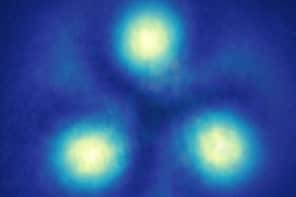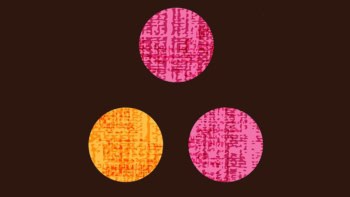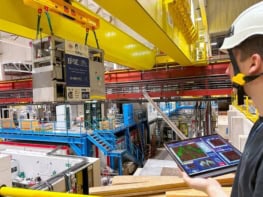
Physicists in France have come up with a new way of using bouncing ultracold atoms to measure the acceleration due to gravity. The technique involves firing vertical laser pulses at a collection of free-falling atoms, which bounces some atoms higher than others. When the atoms recombine at the centre of the experiment, they create an interference pattern that reveals that g is 9.809 m/s2 – just as expected for their Paris lab.
The new technique builds on pioneering work carried out earlier this year by Cass Sackett and his group at the University of Virginia in the US, who were the first to measure gravity by bouncing ultracold rubidium-57 atoms using a laser firing pulses straight up. What happens is that an atom can absorb a photon from the pulse, and then remit a photon but at a slightly different energy. If the timing of the pulses and the momentum absorbed by the atom are just right, the atoms bounce up and down like a gymnast on a trampoline.
However, as the amount of momentum transferred to the atom is quantized, an atom can sometimes receive twice the usual upward momentum – or no upward momentum at all. These breakaway atoms follow different trajectories than the main group – the double-momentum atoms bounce much higher while those that get no extra kick drop down. Although these atoms are initially lost to the main group of regular bouncers, both types can rejoin after time (see figure), creating an interference pattern when the atoms recombine.
Sackett’s team initially sought to minimize the number of atoms lost from the regular bouncers so that they could determine g classically just by measuring how fast the rubidium atoms in this group fall. Sackett’s team then carefully allowed some atoms to follow a second trajectory, and the resulting interference patterns were used to give an even more precise measure of g.
On the bounce
Now, however, Thomas Bourdel and colleagues at the University of Paris and CNRS have shown that g can also be obtained by allowing a fraction of the atoms to take lots of different trajectories and observing the diffraction patterns when they recombine. Bourdel and colleagues began with about 150,000 rubidium-87 atoms that were cooled to ultracold temperature to form a Bose Einstein Condensate (BEC) in which the atoms settle in the same quantum state. The period of the pulses was set at about 1.2 ms and each pulse lasted about 35 µs.
The atoms were bounced by a fixed number of pulses (10–30) before the interference pattern was measured. This allowed the physicists to determine the acceleration due to gravity to be 9.809 m/s2 to three decimal places. This agrees with the local gravity as measured by the World Geodetic System, and slightly more precise than Sackett’s 9.814 ± 0.008 m/s2.
Sackett told physicsworld.com that Bourdel and company were “very creative” to realize that the lost atoms could be recovered and their loss could be turned into a “benefit rather than a hindrance”.
Towards portable gravimeters
The Sackett and Boudrel teams are not the first to measure gravity using ultracold atom interferometry, but other such experiments have involved dropping the atoms in a vacuum chamber, which is limited by the length of the chamber. Although Mark Kasevich and colleagues at Stanford University in the US have built a 10 m drop, such systems are not really practical as portable gravimeters for oil and mineral exploration. Such devices would only be possible if physicists find a way of making “BEC-on-a-chip” technology.
Boudrel and colleagues are now seeking to refine their technique by increasing the number of bounces; changing the shape of the pulses to increase the number of trajectories contributing to the interference pattern; and using photons of higher energy and/or lighter atoms such as helium to increase the time between bounces.
The research will be published in the journal EPL.




